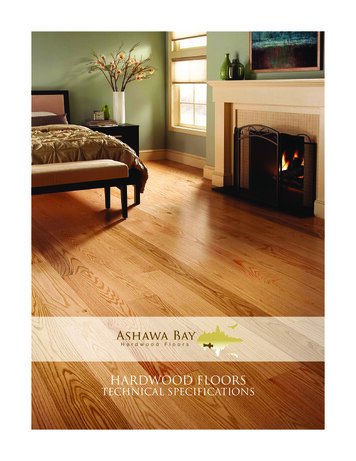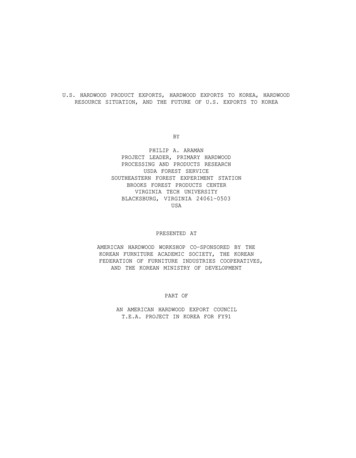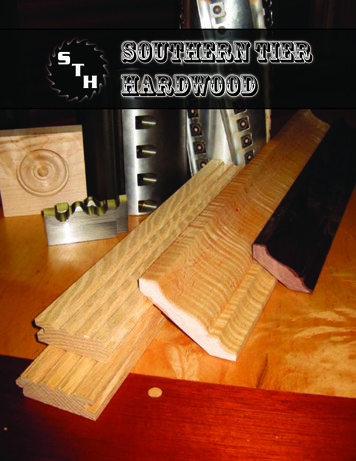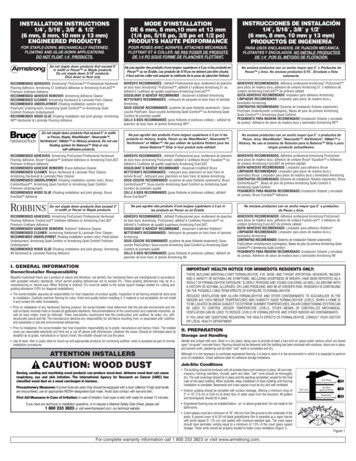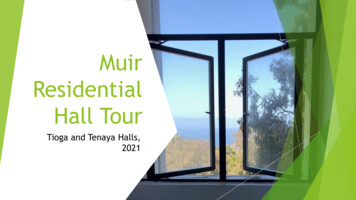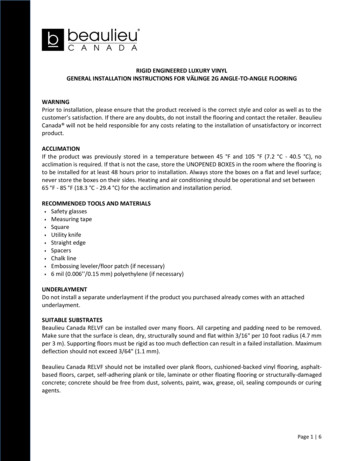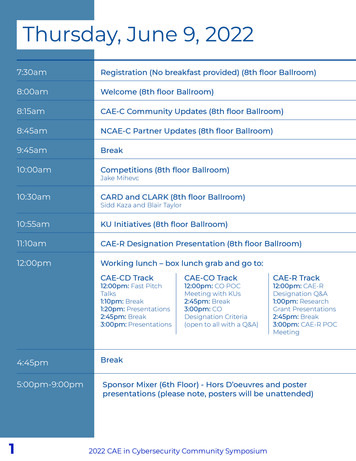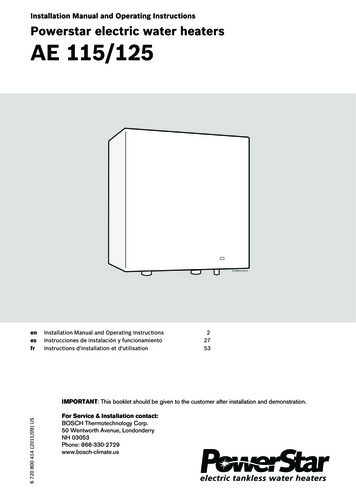
Transcription
Effective date January 20, 2020ENGINEERED HARDWOOD FLOOR INSTALLATION INSTRUCTIONSIMPORTANTIt is important that you read & understand the following information and instructions in their entirety before proceeding withinstallation. Please thoroughly inspect all Flooring products in each carton before installing the product. BuildDirect is not responsiblefor any labour or damages incurred by delivery delays, wrong product, incorrect installation or unacceptable jobsite conditions.Engineered hardwood flooring is a beautiful product with natural variations in color, tone and grain.Therefore we cannot warrant against color variations within a floor or variations between samples and the installed floor. Samplesshould be representative of the wood species & grade and show the milling quality of the product. Color variations may increase overtime with natural exposure to light and air, exotic woods tend to show this more.Do not open the flooring packages until you are ready to begin installation.Work out of several cartons at the same time to insure color and shade mix.INSTALLER/OWNER RESPONSIBILITYOur wood floors are manufactured in accordance with a defect tolerance not to exceed 5-7%. The defects may be manufacturing ornatural. When flooring is ordered 5-7% must be added to the actual square footage needed for cutting and grading allowance. Theinstaller assumes all responsibility for final inspection of product quality. This inspection of all flooring should be done beforeinstallation. Carefully examine flooring for color, manufacturing, factory finish and quality before installing it to ensure it meets thegrade ordered and customers’ expectations. The installer must use reasonable selectivity and remove or cut out pieces with defects,whatever the cause. Slight bowing is acceptable prior to installation and will be eliminated upon laying the next row down withouthampering final installation results.If material is not acceptable, do not install it and contact the seller immediately. Prior to installation of any hardwood flooring product,the installer must determine that the job-site environment and the jobsite sub floor meet or exceed all applicable standards for beingstructurally sound and environmentally acceptable. The construction site and subfloor must be clean, dry, flat and structurally sound.The manufacturer declines any responsibility for failure or deficiencies of the flooring resulting from or associated with subsurface orjobsite environmental conditions.TOOLS & EQUIPMENT NEEDED FOR INSTALLATION Table Handsaw Circular or jigsaw Tape measure Chalk line and chalk Pull bar Hammer Tapping block Wooden or plastic spacer wedges Moisture Meter (can be rented) Broom and dust pan Vacuum cleaner Ear plugs, safety glasses and dust mask Power nailer or stapler Electric drill and bitsFor more information on this product orto order samples call 1-877-631-2845 orvisit our website at builddirect.comPage 1
ENGINEERED HARDWOOD FLOOR INSTALLATION INSTRUCTIONSCAUTION: By not using proper tools, damage may result on face and edge of the plank. BuildDirect is not responsible for problemscaused by use of improper tools. Note: Never hit the planks directly with a hammer–always use a tapping block to protect the edges ofthe boards.PRE-INSTALLATION PROCEDURES & JOBSITE CONDITIONSFor conditioning the hardwood flooring, the HVAC systems should be fully operational at least 14 days prior to flooring installation,maintaining a consistent room temperature between 60 – 80 F with relative humidity between 40 - 55%. This not only stabilizes thebuilding’s interior environment, but also is essential when conditioning hardwood flooring to the job site. Hardwood flooring should behandled and unloaded with care and stored within the environmentally controlled site as recommended above. Flooring stored shouldbe laid flat, not upright and if you have concrete subfloors they should be elevated at least four inches to allow air circulation undercartons. Leave hardwood flooring in closed cartons for as long as necessary to fully acclimate to site conditions. Always measure andkeep a written record of relative humidity, moisture content of sub floor and moisture content of flooring just prior to installation.Room PreparationRemove existing baseboards and thresholds. Undercut doorjambs and other wooden elements attached to walls using a piece offlooring material as a guide allowing for new flooring planks to slide under them. Remove or countersink nails and staples in subfloor.Secure any loose or squeaking subfloor boards, replace if required prior to installation of new flooring.Pre-installation InspectionIt is the responsibility of the installer to inspect each board for visible defects before installation of the flooring. If the defectiveSubfloor PreparationAll subfloors must be structurally sound, clean and free of wax, release agents, paint, oil, curing compounds, drywall mud, urethane,the proper care is taken for removal of this product as well. Subfloors should be flat within 3/16” (4.8 mm) over 10’ (3.1 m) or 1/8” (3.2 mm) over 8’ length. If subfloor prep work is required,“hills” should be sanded down and “valleys” filled with an underlayment patch, developed by a reputable manufacturer for usewith hardwood flooring. Do not sand subsurface such as vinyl or synthetic tiles that may contain asbestos. Subfloors must be structurally sound prior to installation. Screw loose areas to reduce squeaking and replace water damaged ordelaminated sub-flooring or underlayment. It is recommended to moisture test your subfloor prior to installation. Wood subfloor moisture content should not exceed 13%and the moisture content of the wood should be within 4% of the subfloor moisture content. Concrete subfloor tested with acalcium chloride test should not be greater than 3lbs moisture vapour per 1000 SqFt of area. If over 3 lbs moisture vapour per1000 SqFt, a high quality moisture barrier system is required to block vapour transmission. If it is over 7 lbs moisture vapour per1000 SqFt then you should NOT install the flooring. The concrete must be cured a minimum of 30 days prior to testing.Do NOT install the flooring if these limits are exceeded.BuildDirect flooring can be installed over the following subfloors if properly prepared:Concrete: On, above or below grade installations are acceptable. Must be clean, dry and flat within 3/16” (4.8 mm) over 10’ (3.1 m) or1/8” (3.2 mm) over 8’ length. All concrete subfloors must be tested for moisture content, especially adjacent to exterior walls andplumbing fixtures. For on or below grade slab s, determine if a moisture barrier of 6 mil poly film between the earth and concrete ispresent. If unacceptable moisture levels exist, install sheet vinyl (PVC) directly to concrete slab. Follow instructions from sheet vinylmanufacturer, using a premium grade alkaline resistant adhesive and full spread application system to bond vinyl to subfloor. Or asingle component full spread, trowel applied moisture vapour retarder similar to Bostik MVP or Sika T21 or equivalent must be used tobring slab below 3lbs MV per 1000 sqft.For more information on this product orto order samples call 1-877-631-2845 orvisit our website at builddirect.comPage 2
ENGINEERED HARDWOOD FLOOR INSTALLATION INSTRUCTIONSTerrazzo: Should be cleaned with mineral spirits and lightly sanded/abraded prior to spreading the adhesive. Allow the mineral spiritsto dry prior to spreading the adhesive.Ceramic Tile: Tiles must be securely fastened to the subfloor. If grout lines are too deep they need to be filled. If using glue-downinstallation, surface should be roughed up with a san der or grinder and cleaned to remove all dust. If grout lines are too deep theyneed to be filled.Wood Type Subfloors: Plywood: minimum 5/8” thick with maximum spacing 16” on center joist construction or ¾” thick with maximum19.2” on center joist construction. OSB: minimum thickness 23/32” OSB with maximum spacing 19.2” on center joist construction.Particle Board: Floating installation is only permitted. Squeaks and popping areas should be repaired prior to flooring installation on allwood subfloors.Vinyl: Includes sheet and vinyl tile. Vinyl must be securely fastened to the subfloor with full spread adhesive. Loose laid or perimeterglued sheet vinyl must be removed. Do not install over more than one layer that is thicker than 1/8”.Glue-down installation is not recommended over vinyl since light sanding would be required and existing vinyl may contain asbestosfibers that are not identifiable. Inhaling asbestos dust is extremely hazardous to your health. Ensure the proper care is taken forremoval of this product as well.Moisture BarrierAll concrete subfloors must be tested for moisture content, especially adjacent to exterior walls and plumbing fixtures. For on or belowgrade slabs, determine if a moisture barrier of 6 mil pol y film between the earth and concrete is present. If unacceptable moisturelevels exist, install sheet vinyl (PVC) directly to concrete slab. Follow instructions from sheet vinyl manufacturer, using a premiumgrade alkaline resistant adhesive and full spread application system to bond vinyl to subfloor. Or a single component full spread, trowelapplied moisture vapour retarderSet UpIn order to have sufficient material at hand, calculate area and add 5% of material to allow cutting waste and for minor natural ormanufacturers defects. Work out of several cartons at the same time to ensure color and shade mix.LayoutLayout should be designed to save labor and materials as well as to enhance the appearance of the floor. The floor will be strongerand more stable if you lay it so that the joints in the rows are staggered at least 8” (203.2 mm). Staggered or irregular joints mean lessmaterial waste and a better overall appearance.Plan the layout so that the last row of flooring (which usually needs to be cut lengthwise) is not too narrow. In some cases, it may benecessary to cut the first row as well as the last row. Allow 1/2” (12.7 mm) expansion space along all walls. Flooring should be laid atright angle to the floor joist and, if possible, in the direction of the longest dimension of the room.NAIL-DOWN OR STAPLE-DOWN INSTALLATIONSubfloor PreparationRemove all dirt and rough areas by thoroughly cleaning, sanding and flattening subfloor. Note: Particle board is not a suitable subfloorfor nail-down or staple-down installation. The clean subfloor should be covered wall-to-wall with 15 lb. (6.8 Kg) resin paper,overlapping 4” (101.6 mm) along the edges.For more information on this product orto order samples call 1-877-631-2845 orvisit our website at builddirect.comPage 3
ENGINEERED HARDWOOD FLOOR INSTALLATION INSTRUCTIONSInstallationTo determine a straight first starting row, use a snap line the width of a few boards plus 1/2” (12.7 mm) expansion space from the wall.To keep first rows straight and in place, nail a straight 1 x 2 or 1 x 4 “holding board” on the first snap line, being sure to maintain thestraight line. For nailer or stapler, use correct shoe based on thickness of flooring. If using pneumatic fasteners set the compressorpressure to recommended PSI and adjust accordingly using a “practice” board. Check for surface and tongue damage beforeproceeding with installation. Begin installation with several rows at a time, tightening boards as necessary to reduce gaps beforefastening. Attach each board placing fasteners; narrow crowned (under 3/8” or 10mm) 1”-1½” (25-40mm) staples or 18Ga1”-1¼” (25-32 mm) hardwood flooring cleats “L” designed for engineered flooring, spaced every 3”-4”(75–100mm) with staples, every 4”-6” (100-150mm) with cleats, and within the 1”-2” (25-50mm) area of end joints. The last 1-2 rowswill need to be face nailed where clearance does not allow blind nailing with stapler or nailer.Installation InstructionsRip the final row to fit and face nail. If the final row is less than 1” (25.4 mm) width, it should be edge- glued to the previous row, beforeinstallation. The two joined rows can be face nailed as one board. Go back to the starting wall, remove the starting block and completefinal rows using 2” (50.8 mm) 6d nails, counter sun k and filled.GLUE-DOWN INSTALLATION Urethane based adhesive is required. Concrete subfloor tested with a calcium chloride test should not be greater than 3 lbs per 1000 SqFt of area. If over 3 lbs per 1000SqFt, a high quality moisture barrier system is required. To determine a straight first starting row, use a snap line the width of a few boards plus 1/2” (13 mm) expansion space from thewall. To keep first rows straight and in place, nail a straight 1 x 2 or 1 x 4 “holding board” on the first snap line, being sure tomaintain the straight line. Make another snap line at a comfortable “arms reach” distance from the holding board about 24” (609.6 mm) or multiples of thewidth of flooring to a maximum of comfortable “ arms reach”. Spread adhesive in first working area. Do not spread more adhesive than can be covered within 20 minutes. Install the flooringwith the tongue against the holding board continuing along the edge maintaining a straight edge. Continue row to row tapingseams as required using 3M Blue Tape. When the first section is complete, strike another parallel snap line from the last row installed, spread the adhesive and completethe section. Repeat section by section until the job is finished. Remove the starting board, spread adhesive and complete the area from thestarting board to the wall.FLOATING INSTALLATIONInstall Underlayment Pad:Install 6 mil Polyethylene vapor barrier over entire flooring surface. Run vapour barrier up walls 2” to 3” (50 mm to 75 mm) and securein place with tape. Overlap sheets of Polyethylene 16” and tape together creating an airtight seal. Apply underlayment over vapourbarrier being careful not to poke holes or otherwise damage material during installation. Join padding sections with tape strip and tapedown any additional loose edges. A “2-in-1 or 3-in-1” underlayment /moisture barrier may be substituted for two separate productslisted above.For more information on this product orto order samples call 1-877-631-2845 orvisit our website at builddirect.comPage 4
ENGINEERED HARDWOOD FLOOR INSTALLATION INSTRUCTIONSInstalling the Boards:Boards are installed left to right with the groove side facing the wall. Avoid establishing a stair-step pattern that will be repeatedthroughout installation. Stagger the ends of the boards a minim um of 8” (203.2 mm). Leave a minimum 1/2” (12 mm) expansion aroundall vertical objects such as walls, posts, and stairs. If starting wall is uneven, trace the contour of wall, using a scriber, onto first row ofplanks and cut to size.Application of Adhesive:For T&G products only do not apply adhesive to locking systems. To secure a durable wood floor the boards must be bonded withadhesive in the tongue and groove. We recommend waterproof PVA glue (Titebond Tongue & Groove Glue) that is engineered forfloating floors. The glue must be applied in a continuous 1/8” (3.2 mm) bead on the inside top of the groove on both the long andshort edges. Dry fit first row avoid using a stair-step pattern. Number each plank in the order of installation. When you reach the lastplank in first row, turn plank 180 so tongue is flush against tongue of previous plank. Mark the plank and cut to length. Dry fit finalplank of row. Begin dry fitting second row, starting with (if possible) left over piece from previous row. Be sure to stagger end ofboards at least 8” (200 mm). Floating installation is completed by gluing and taping flooring profiles together. Separate first two rowsnoting installation order.Holding the first board with the tongue resting in the palm of y our hand, apply a thin bead of glue in the groove on the side and end ofthe board. Repeat process with subsequent planks. Press each board firmly together, tapping profiles lightly with a block and hammer ifnecessary. Clean excess glue from between boards with a damp cloth. Tape each board together at side and end seams using 3M BlueTape. Often the last row will not end with a full plank. When this happens, place a full row of planks on top of the last row installed.Insert a 1/2” (12 mm) spacer against wall, and using a full width plank, trace distance from wall onto final row. Cut planks for final row todesignated width. Apply glue and fit into place. Tape may be removed within one hour. Allow 12 hours before placing furniture on floorsand 24 hours before introducing heavy objects or full traffic.Note: Do not install cabinets or walls on top of floating floors.INSTALLATION OVER RADIANT HEATImportant Note: Brazilian Cherry flooring is NOT supported for installation with Radiant Heat systems. Heating System maximum allowable temperature is 80 F (26 C). The subfloor should be completely dry and cured for a minimum of 4 weeks prior to operation of radiant system. System should run at normal temperature (typically 2/3 maximum output) for a minimum of 21 days prior to floor installation tofurther allow moisture from concrete to dissipate and reach final moisture content reading. The heating system must be turned off 24 hours prior to installation and must remain off for 24 hours after installation. Starting 2 days after completion of installation, gradually increase the temperature over a 7 day period to normal operating level.Never allow the floor surface temp to exceed 80 F (26 C). Room temperature should not vary more than 15 F (9 C). Maintain 40 to 55% humidity in radiant heated rooms. Heating pipes must be covered with 1” of concrete or be a minim um of 1/8” (3.2 mm) below bottom of plywood subfloor. Under plywood subfloors heat transfer plates or insulation must be in place. Use Installation Instructions previously listed. For floating floors, the use of a 2-in-1 underlayment is required.Maple flooring expands and contracts more than other wood types, especially when installed over radiant heating systems. You shouldallow for larger expansion gap than other wood species – minimum ¾” - around all vertical objects such as walls, poles, and stairsexpansion. Such gaps are not manufacturing defects. Take the above into consideration when choosing a wood type to be installedover radiant heat.For more information on this product orto order samples call 1-877-631-2845 orvisit our website at builddirect.comPage 5
ENGINEERED HARDWOOD FLOOR INSTALLATION INSTRUCTIONSALL INSTALLATIONS: COMPLETING THE JOB Remove spacer wedges after waiting a minimum of 12 hours after installation. At completion of the installation, vacuum thoroughly and clean the floor with proper wood flooring cleaner on a soft cloth mop.Then wipe the surface clean to remove loose dirt or soil. Use stain, filler or a putty stick to touch up pieces that may have been damaged during installation or any defective pieces thatwere installed. Install any transition pieces that may be required, such as reducers, T-moldings and stair nosing. Keep several spare boards from the installation in the event of future repairs.For more information on this product orto order samples call 1-877-631-2845 orvisit our website at builddirect.comPage 6
Engineered hardwood flooring is a beautiful product with natural variations in color, tone and grain. . Our wood floors are manufactured in accordance with a defect tolerance not to exceed 5-7%. The defects may be manufacturing or natural. When flooring is ordered 5-7% must be added to the actual square footage needed for cutting and grading .
